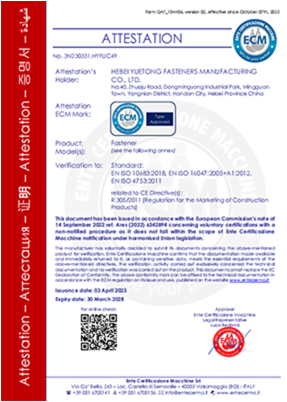अगस्त . 07, 2024 13:00 Back to list
Understanding the Applications and Benefits of M16 Threaded Bars in Construction and Engineering Projects
Understanding M16 Threaded Bars Applications and Advantages
In the realm of construction and engineering, threaded bars serve as essential components for ensuring stability and structural integrity. Among these, the M16 threaded bar stands out due to its standardized dimensions and versatile applications. This article delves into the characteristics, uses, benefits, and considerations when utilizing M16 threaded bars in various projects.
What is an M16 Threaded Bar?
The designation M16 refers to the metric thread size, wherein M signifies that the thread is metric, and 16 indicates a nominal diameter of 16 millimeters. Threaded bars, also known as rods or studs, are long, cylindrical pieces of metal with helical grooves spiraling along their length. These grooves allow for the attachment of nuts and other fasteners, making them crucial for various mechanical and structural applications.
Manufactured from different materials such as steel, stainless steel, and sometimes even composite materials, M16 threaded bars possess the necessary strength and durability for demanding environments. The most common grades used for these bars include properties suitable for construction, ensuring effective load distribution and resistance to tensile forces.
Applications of M16 Threaded Bars
M16 threaded bars are extensively used in numerous construction and engineering applications. Some prominent uses include
1. Construction and Civil Engineering M16 threaded bars are commonly used in reinforced concrete applications. They can serve as anchor bolts, tie rods, or tension bars, providing crucial tensioning capabilities to develop reinforced structures.
2. Structural Steelworks In structural steel construction, M16 threaded bars are often employed to connect various steel components, ensuring stability and integrity of the overall structure.
3. Mechanical Engineering These threaded bars are essential in manufacturing and assembly processes. They secure components, providing adjustable tension and critical alignment necessary for machine operation.
m16 threaded bar

5. Bracing Systems They are utilized in bracing systems within buildings and bridges, helping to resist lateral loads caused by wind or seismic activity.
Advantages of M16 Threaded Bars
The popularity of M16 threaded bars can be attributed to several key advantages
1. Versatility Their standardized size makes M16 threaded bars compatible with a wide range of nuts, washers, and other fastening components, allowing adaptable use in different projects.
2. Strength and Stability Manufactured to high standards, M16 threaded bars exhibit exceptional tensile strength, making them ideal for load-bearing applications.
3. Ease of Installation The thread configuration allows for quick and easy assembly and disassembly, making construction processes more efficient.
4. Corrosion Resistance When made from stainless steel or treated for corrosion resistance, M16 threaded bars can endure harsh environmental conditions, extending their lifespan in outdoor applications.
5. Cost-Effective Given their durability and the strength they provide, M16 threaded bars can be a cost-effective solution for many construction and engineering needs, minimizing the necessity for frequent replacements.
Considerations When Using M16 Threaded Bars
While M16 threaded bars offer numerous advantages, several factors should be considered during their application. These include the environmental conditions, load requirements, and type of materials to be connected. Proper selection of the grade and finish is vital to ensure optimal performance and longevity.
In conclusion, M16 threaded bars play an indispensable role in modern engineering and construction. Their design, coupled with versatility and strength, makes them suitable for a wide range of applications, from foundational work to intricate mechanical assemblies. Understanding their properties and applications can significantly enhance design efficiency and structural reliability in any project.
-
The Ubiquitous Reach of DIN934 in Application Realms
NewsMay.16,2025
-
Exploring Different Bolt Types
NewsMay.16,2025
-
Cracking the Code of Sleeve Anchor Mastery
NewsMay.16,2025
-
Clamp Design Principles,Types and Innovations
NewsMay.16,2025
-
Artistry Inspired by the Humble Anchor Bolt
NewsMay.16,2025
-
A Deep Dive into Screw Types
NewsMay.16,2025


